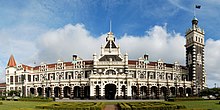Ototara limestone
The Ototara Limestone , commonly known as Oamaru stone , is a light cream colored limestone native to the area around Oamaru , New Zealand . The time when the stone was created is classified in the regional geological level of the Whaingaroan . This stage corresponds to the global Lower Oligocene and can therefore be assigned to the period from 33.9 to 28.1 million years ago in absolute age values.
geography
The area in which the Ototara Limestone is found is part of a larger contiguous landscape that includes the southern part of Canterbury and largely the coastal area of Otago . The Oamaru stone is currently only being mined in Parkside Quarry near Weston , 6 km northwest of Oamaru city center. Approximately 450 megatons of the quality of the Ototara Limestone are believed to be in the Oamaru area .
nature
The limestone is coarsely structured, porous and, despite its relatively light weight, solid. Its color is light brown and blends in creamy white. Its partly large, colored stripes give sculptures made from the stone a special atmosphere. The stone is easy to cut and is therefore particularly suitable as a building material in the form of a cuboid .
The calcium carbonate CaCO 3 content is between 86% and 98%, but mostly over 93%. The proportions of silicon dioxide SiO 2 are around 1%, iron (III) oxide Fe 2 O 3 is 0.43% and aluminum oxide Al 2 O 3 is 0.5%. The Ototara Limestone has the reputation of being the best quality limestone in the Otago region because of its texture and properties .
use
Since the limestone has good processing properties and looks very appealing due to its color structure, it is very popular in house construction and facade design. Especially in Otago , but also nationwide, the Oamaru Stone has been used in the construction of stone structures since the 1860s. Initially, the limestone was mostly used in church buildings, buildings of banks, town halls, theater buildings and other public buildings or in private residences as a load-bearing stone and at the same time as a design element.
The image of the historic city center of Oamaru is shaped by buildings made of Oamaru Stone . Many of these structures were designed by the Forrester & Lemon architectural association. In other buildings, the light stone was combined with hard, blue-gray basalt ("bluestone") as a contrast, for example at Dunedin Railway Station , the University of Otago Registry Building and the Christchurch Arts Center .
Today the Oamaru stone is only used as a building material for facade cladding, for decorative interior walls or smaller buildings, since the limestone is difficult to withstand earthquakes due to its low strength . In 2009 the Otago District Council tried to ban limestone as a building material for building houses. Limestone is widely used for the production of stone sculptures; some artists in the region work almost exclusively with this stone.
literature
- PJ Forsyth : Geology of the Waitaki Area . Ed .: Institute of Geological & Nuclear Sciences Limited . Lower Hutt 2001, ISBN 0-478-09739-5 (English).
- Bob Brathwaiten, Tony Christie, Bruce Thompson : Mineral Commodity Report 21 - Limestone, marble and dolomite . Ed .: Institute of Geological & Nuclear Sciences Limited . Lower Hutt 2000 (English).
Web links
Individual evidence
- ^ A b P. J. Forsyth : Geology of the Waitaki Area . Ed .: Institute of Geological & Nuclear Sciences Limited . Lower Hutt 2001, ISBN 0-478-09739-5 , pp. 46.47 (English).
- ↑ Geological Society of New Zealand Inc 2003 Annual Conference 1 - 4 December University of Otago Dunedin Field Trip Guides Compiled by Simon Cox & Belinda Smith Lyttle PDF (S.FT8-7)
- ↑ Totara Estate Granary (Barn) l . New Zealand Historic Places Trust , accessed December 26, 2011 .
- ↑ a b Bob Brathwaiten, Tony Christie, Bruce Thompson : Mineral Commodity Report 21 - Limestone, marble and dolomite - Coastal Otago . Ed .: Institute of Geological & Nuclear Sciences Limited . Lower Hutt 2000 (English).
- ^ Jason M. Ingham : The Performance of Unreinforced Masonry Buildings in the 2010/2011 Canterbury Earthquake Swarm . Ed .: The University of Auckland . Auckland 2011, p. 65 (English, report to the Royal Commission of Inquiry ).
- ^ Lynda Van Kempen : Oamaru stone banned in Central . Otago Daily Times , August 5, 2009, accessed December 26, 2011 .




